A Scoping Review of Marginal and Internal Fit Accuracy of Lithium Disilicate Restorations
Abstract
:1. Introduction
2. Materials and Methods
2.1. Protocol Development
2.2. Search Strategy
2.3. Study Selection and Data Extraction
2.4. Quality of Evidence Assessment
2.5. Analysis
2.6. Meta-Analysis
3. Results
3.1. Study Characteristics
3.2. Outcome of Studies
3.3. Risk of Bias in Studies
3.4. Synthesis of the Meta-Analysis
4. Discussion
4.1. Summary of Evidence
4.2. Measurement Technique
4.3. Internal Fit
4.4. Onlays
4.5. CAD/CAM and Milling Machines
4.6. Limitations
4.7. Future Developments
5. Conclusions
Author Contributions
Funding
Institutional Review Board Statement
Informed Consent Statement
Data Availability Statement
Acknowledgments
Conflicts of Interest
References
- Papadiochos, I.; Papadiochou, S.; Emmanouil, I. The Historical Evolution of Dental Impression Materials. J. Hist. Dent. 2017, 65, 79–89. [Google Scholar] [PubMed]
- Ender, A.; Mehl, A. Accuracy of complete-arch dental impressions: A new method of measuring trueness and precision. J. Prosthet. Dent. 2013, 109, 121–128. [Google Scholar] [CrossRef] [Green Version]
- Javaid, M.; Haleem, A.; Khan, S.; Luthra, S. Different Flexibilities of 3D Scanners and Their Impact on Distinctive Applications: An Analysis. Int. J. Bus. Anal. 2020, 7, 37–53. [Google Scholar] [CrossRef]
- Sjögren, G. Marginal and internal fit of four different types of ceramic inlays after luting an in vitro study. Acta Odontol. Scand. 1995, 53, 24–28. [Google Scholar] [CrossRef]
- Thongthammachat, S.; Moore, B.K.; Barco, M.T.; Hovijitra, S.; Brown, D.T.; Andres, C.J. Dimensional accuracy of dental casts: Influence of tray material, impression material, and time. J. Prosthodont. 2002, 11, 98–108. [Google Scholar] [CrossRef] [PubMed]
- Mangano, F.G.; Veronesi, G.; Hauschild, U.; Mijiritsky, E.; Mangano, C. Trueness and Precision of Four Intraoral Scanners in Oral Implantology: A Comparative in Vitro Study. PLoS ONE 2016, 11, e0163107. [Google Scholar] [CrossRef] [PubMed]
- Al-Imam, H.; Gram, M.; Benetti, A.R.; Gotfredsen, K. Accuracy of stereolithography additive casts used in a digital workflow. J. Prosthet. Dent. 2018, 119, 580–585. [Google Scholar] [CrossRef]
- Liu, Q.; Leu, M.C.; Schmitt, S.M. Rapid prototyping in dentistry: Technology and application. Int. J. Adv. Manuf. Technol. 2005, 29, 317–335. [Google Scholar] [CrossRef]
- Örtorp, A.; Jönsson, D.; Mouhsen, A.; von Steyern, P.V. The fit of cobalt–chromium three-unit fixed dental prostheses fabricated with four different techniques: A comparative in vitro study. Dent. Mater. 2011, 27, 356–363. [Google Scholar] [CrossRef]
- Ting-Shu, S.; Jian, S. Intraoral Digital Impression Technique: A Review. J. Prosthodont. 2014, 24, 313–321. [Google Scholar] [CrossRef]
- Quaas, S.; Rudolph, H.; Luthardt, R.G. Direct mechanical data acquisition of dental impressions for the manufacturing of CAD/CAM restorations. J. Dent. 2007, 35, 903–908. [Google Scholar] [CrossRef] [PubMed]
- Anadioti, E.; Aquilino, S.A.; Gratton, D.G.; Holloway, J.A.; Denry, I.; Thomas, G.W.; Qian, F. 3D and 2D Marginal Fit of Pressed and CAD/CAM Lithium Disilicate Crowns Made from Digital and Conventional Impressions. J. Prosthodont. 2014, 23, 610–617. [Google Scholar] [CrossRef] [PubMed]
- Roulet, J. Marginal integrity: Clinical significance. J. Dent. 1994, 22, S9–S12. [Google Scholar] [CrossRef]
- Holmes, J.R.; Bayne, S.C.; Holland, G.A.; Sulik, W.D. Considerations in measurement of marginal fit. J. Prosthet. Dent. 1989, 62, 405–408. [Google Scholar] [CrossRef] [PubMed]
- Christensen, G.J. Marginal fit of gold inlay castings. J. Prosthet. Dent. 1966, 16, 297–305. [Google Scholar] [CrossRef] [PubMed]
- Reich, S.; Gozdowski, S.; Trentzsch, L.; Frankenberger, R.; Lohbauer, U. Marginal Fit of Heat-pressed vs CAD/CAM Processed All-ceramic Onlays Using a Milling Unit Prototype. Oper. Dent. 2008, 33, 644–650. [Google Scholar] [CrossRef] [PubMed] [Green Version]
- Pjetursson, B.E.; Sailer, I.; Makarov, N.A.; Zwahlen, M.; Thoma, D.S. All-ceramic or metal-ceramic tooth-supported fixed dental prostheses (FDPs)? A systematic review of the survival and complication rates. Part II: Multiple-unit FDPs. Dent. Mater. 2015, 31, 624–639. [Google Scholar] [CrossRef] [Green Version]
- Lang, N.P.; Kiel, R.A.; Anderhalden, K. Clinical and microbiological effects of subgingival restorations with overhanging or clinically perfect margins. J. Clin. Periodontol. 1983, 10, 563–578. [Google Scholar] [CrossRef]
- Conrad, H.J.; Seong, W.-J.; Pesun, I.J. Current ceramic materials and systems with clinical recommendations: A systematic review. J. Prosthet. Dent. 2007, 98, 389–404. [Google Scholar] [CrossRef]
- Baldi, A.; Comba, A.; Ferrero, G.; Italia, E.; Dds, R.M.T.; Paolone, G.; Mazzoni, A.; Breschi, L.; Scotti, N.; Dds, A.B.; et al. External gap progression after cyclic fatigue of adhesive overlays and crowns made with high translucency zirconia or lithium silicate. J. Esthet. Restor. Dent. 2021, 34, 557–564. [Google Scholar] [CrossRef]
- Moher, D.; Liberati, A.; Tetzlaff, J.; Altman, D.G.; PRISMA Group. Preferred reporting items for systematic reviews and meta-analyses: The PRISMA statement. PLoS Med. 2009, 6, e1000097. [Google Scholar] [CrossRef] [PubMed] [Green Version]
- Slim, K.; Nini, E.; Forestier, D.; Kwiatkowski, F.; Panis, Y.; Chipponi, J. Methodological index for non-randomized studies (MINORS ): Development and validation of a new instrument. ANZ J. Surg. 2003, 73, 712–716. [Google Scholar] [CrossRef] [PubMed]
- Neves, F.D.; Prado, C.J.; Prudente, M.S.; Carneiro, T.A.; Zancope, K.; Davi, L.R.; Mendonca, G.; Cooper, L.F.; Soares, C.J. Micro-computed tomography evaluation of marginal fit of lithium disilicate crowns fabricated by using chairside CAD/CAM systems or the heat-pressing technique. J. Prosthet. Dent. 2014, 112, 1134–1140. [Google Scholar] [CrossRef]
- Ng, J.; Ruse, D.; Wyatt, C. A comparison of the marginal fit of crowns fabricated with digital and conventional methods. J. Prosthet. Dent. 2014, 112, 555–560. [Google Scholar] [CrossRef] [PubMed]
- Abdel-Azim, T.; Rogers, K.; Elathamna, E.; Zandinejad, A.; Metz, M.; Morton, D. Comparison of the marginal fit of lithium disilicate crowns fabricated with CAD/CAM technology by using conventional impressions and two intraoral digital scanners. J. Prosthet. Dent. 2015, 114, 554–559. [Google Scholar] [CrossRef]
- Kim, J.-H.; Jeong, J.-H.; Lee, J.-H.; Cho, H.-W. Fit of lithium disilicate crowns fabricated from conventional and digital impressions assessed with micro-CT. J. Prosthet. Dent. 2016, 116, 551–557. [Google Scholar] [CrossRef]
- Alqahtani, F. Marginal fit of all-ceramic crowns fabricated using two extraoral CAD/CAM systems in comparison with the conventional technique. Clin. Cosmet. Investig. Dent. 2017, 9, 13–18. [Google Scholar] [CrossRef] [Green Version]
- Zeltner, M.; Sailer, I.; Mühlemann, S.; Özcan, M.; Hämmerle, C.H.; Benic, G.I. Randomized controlled within-subject evaluation of digital and conventional workflows for the fabrication of lithium disilicate single crowns. Part III: Marginal and internal fit. J. Prosthet. Dent. 2017, 117, 354–362. [Google Scholar] [CrossRef] [PubMed] [Green Version]
- Azar, B.; Eckert, S.; Kunkela, J.; Ingr, T.; Mounajjed, R. The marginal fit of lithium disilicate crowns: Press vs. CAD/CAM. Braz. Oral Res. 2018, 32, e001. [Google Scholar] [CrossRef] [PubMed] [Green Version]
- Mostafa, N.Z.; Ruse, N.D.; Ford, N.L.; Carvalho, R.M.; Wyatt, C.C.L. Marginal Fit of Lithium Disilicate Crowns Fabricated Using Conventional and Digital Methodology: A Three-Dimensional Analysis. J. Prosthodont. 2017, 27, 145–152. [Google Scholar] [CrossRef]
- Revilla-León, M.; Olea-Vielba, M.; Esteso-Saiz, A.; Martínez-Klemm, I.; Özcan, M. Marginal and Internal Gap of Handmade, Milled and 3D Printed Additive Manufactured Patterns for Pressed Lithium Disilicate Onlay Restorations. Eur. J. Prosthodont. Restor. Dent. 2018, 26, 31–38. [Google Scholar]
- Al Hamad, K.Q.; Al Rashdan, B.A.; Al Omari, W.M.; Baba, N.Z. Comparison of the Fit of Lithium Disilicate Crowns made from Conventional, Digital, or Conventional/Digital Techniques. J. Prosthodont. 2018, 28, e580–e586. [Google Scholar] [CrossRef]
- Alkahtani, A.H.; Elrashid, A.H.; Alqahtani, S.J.; Alajmi, N.B.; Alsultan, F.H. Stereomicroscopic evaluation of marginal fit of E.Max press and E.Max computer-aided design and computer-assisted manufacturing lithium disilicate ceramic crowns: An in vitro study. J. Int. Soc. Prev. Community Dent. 2019, 9, 178–184. [Google Scholar] [CrossRef]
- Gudugunta, L.; Mynampati, P.; Jeevan, M.B.; Kumar, S.M.; Akkaloori, A.; Tejavath, S.K. The marginal discrepancy of lithium disilicate onlays: Computer-aided design versus press. J. Conserv. Dent. 2019, 22, 336–339. [Google Scholar] [CrossRef]
- Ahn, J.-J.; Bae, E.-B.; Lee, J.-J.; Choi, J.-W.; Jeon, Y.-C.; Jeong, C.-M.; Yun, M.-J.; Lee, S.-H.; Lee, K.-B.; Huh, J.-B. Clinical evaluation of the fit of lithium disilicate crowns fabricated with three different CAD-CAM systems. J. Prosthet. Dent. 2020, 127, 239–247. [Google Scholar] [CrossRef]
- Kwong, B.; Dudley, J. A comparison of the marginal gaps of lithium disilicate crowns fabricated by two different intraoral scanners. Aust. Dent. J. 2020, 65, 150–157. [Google Scholar] [CrossRef]
- Lee, J.-H.; Son, K.; Lee, K.-B. Marginal and Internal Fit of Ceramic Restorations Fabricated Using Digital Scanning and Conventional Impressions: A Clinical Study. J. Clin. Med. 2020, 9, 4035. [Google Scholar] [CrossRef]
- Ferrairo, B.M.; Piras, F.F.; Lima, F.F.; Honório, H.M.; Duarte, M.A.H.; Borges, A.F.S.; Rubo, J.H. Comparison of marginal adaptation and internal fit of monolithic lithium disilicate crowns produced by 4 different CAD/CAM systems. Clin. Oral Investig. 2020, 25, 2029–2036. [Google Scholar] [CrossRef]
- Goujat, A.; Abouelleil, H.; Colon, P.; Jeannin, C.; Pradelle, N.; Seux, D.; Grosgogeat, B. Marginal and internal fit of CAD-CAM inlay/onlay restorations: A systematic review of in vitro studies. J. Prosthet. Dent. 2019, 121, 590–597.e3. [Google Scholar] [CrossRef]
- Hasanzade, M.; Shirani, M.; Afrashtehfar, K.I.; Naseri, P.; Alikhasi, M. In Vivo and In Vitro Comparison of Internal and Marginal Fit of Digital and Conventional Impressions for Full-Coverage Fixed Restorations: A Systematic Review and Meta-analysis. J. Evid. Based Dent. Pract. 2019, 19, 236–254. [Google Scholar] [CrossRef]
- Cicciù, M.; Fiorillo, L.; D’Amico, C.; Gambino, D.; Amantia, E.M.; Laino, L.; Crimi, S.; Campagna, P.; Bianchi, A.; Herford, A.S.; et al. 3D Digital Impression Systems Compared with Traditional Techniques in Dentistry: A Recent Data Systematic Review. Materials 2020, 13, 1982. [Google Scholar] [CrossRef]
- Pelekanos, S.; Koumanou, M.; Koutayas, S.-O.; Zinelis, S.; Eliades, G. Micro-CT evaluation of the marginal fit of different In-Ceram alumina copings. Eur. J. Esthet. Dent. 2009, 4, 278–292. [Google Scholar]
- Molin, M.; Karlsson, S. The fit of gold inlays and three ceramic inlay systems: A clinical and in vitro study. Acta Odontol. Scand. 1993, 51, 201–206. [Google Scholar] [CrossRef]
- Nawafleh, N.A.; Mack, F.; Evans, J.L.; Mackay, J.; Hatamleh, M.M. Accuracy and Reliability of Methods to Measure Marginal Adaptation of Crowns and FDPs: A Literature Review. J. Prosthodont. 2013, 22, 419–428. [Google Scholar] [CrossRef] [Green Version]
- Zimmermann, M.; Ender, A.; Mehl, A. Local accuracy of actual intraoral scanning systems for single-tooth preparations in vitro. J. Am. Dent. Assoc. 2019, 151, 127–135. [Google Scholar] [CrossRef]
- Alfaro, D.P.; Ruse, N.D.; Carvalho, R.M.; Wyatt, C.C. Assessment of the Internal Fit of Lithium Disilicate Crowns Using Micro-CT. J. Prosthodont. 2015, 24, 381–386. [Google Scholar] [CrossRef]
- Yu, H.; Zhao, Y.; Li, J.; Luo, T.; Gao, J.; Liu, H.; Liu, W.; Liu, F.; Zhao, K.; Liu, F.; et al. Minimal invasive microscopic tooth preparation in esthetic restoration: A specialist consensus. Int. J. Oral Sci. 2019, 11, 31. [Google Scholar] [CrossRef] [Green Version]
- Kunii, J.; Hotta, Y.; Tamaki, Y.; Ozawa, A.; Kobayashi, Y.; Fujishima, A.; Miyazaki, T.; Fujiwara, T. Effect of Sintering on the Marginal and Internal Fit of CAD/CAM-fabricated Zirconia Frameworks. Dent. Mater. J. 2007, 26, 820–826. [Google Scholar] [CrossRef] [Green Version]
- Vennerstrom, M.; Fakhary, M.; Von Steyern, P.V. The fit of crowns produced using digital impression systems. Swed. Dent. J. 2014, 38, 101–110. [Google Scholar]
- Bosch, G.; Ender, A.; Mehl, A. A 3-dimensional accuracy analysis of chairside CAD/CAM milling processes. J. Prosthet. Dent. 2014, 112, 1425–1431. [Google Scholar] [CrossRef] [Green Version]
- McLean, J.W.; von Fraunhofer, J.A. The estimation of cement film thickness by an in vivo technique. Br. Dent, J. 1971, 131, 107–111. [Google Scholar] [CrossRef]
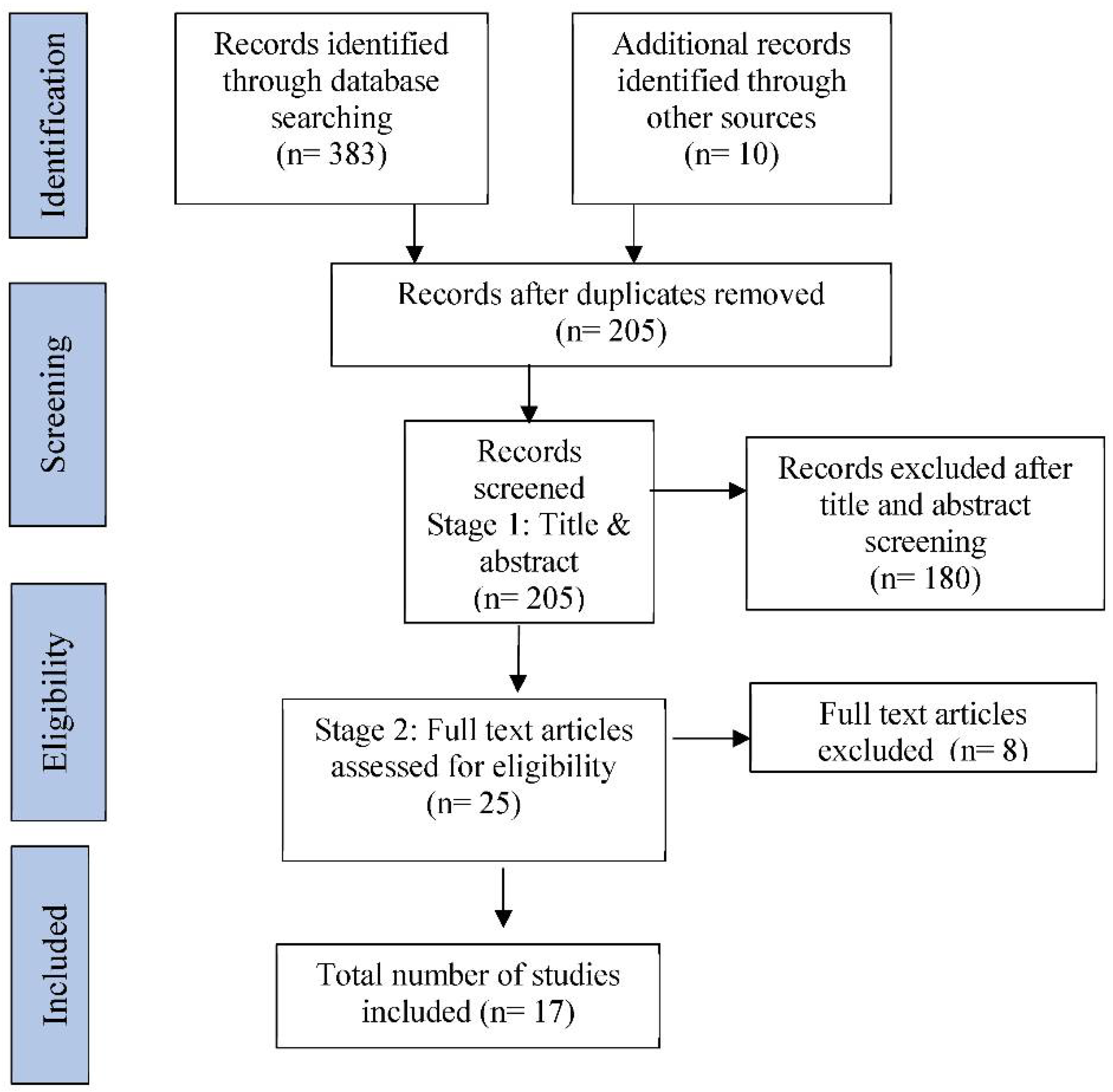
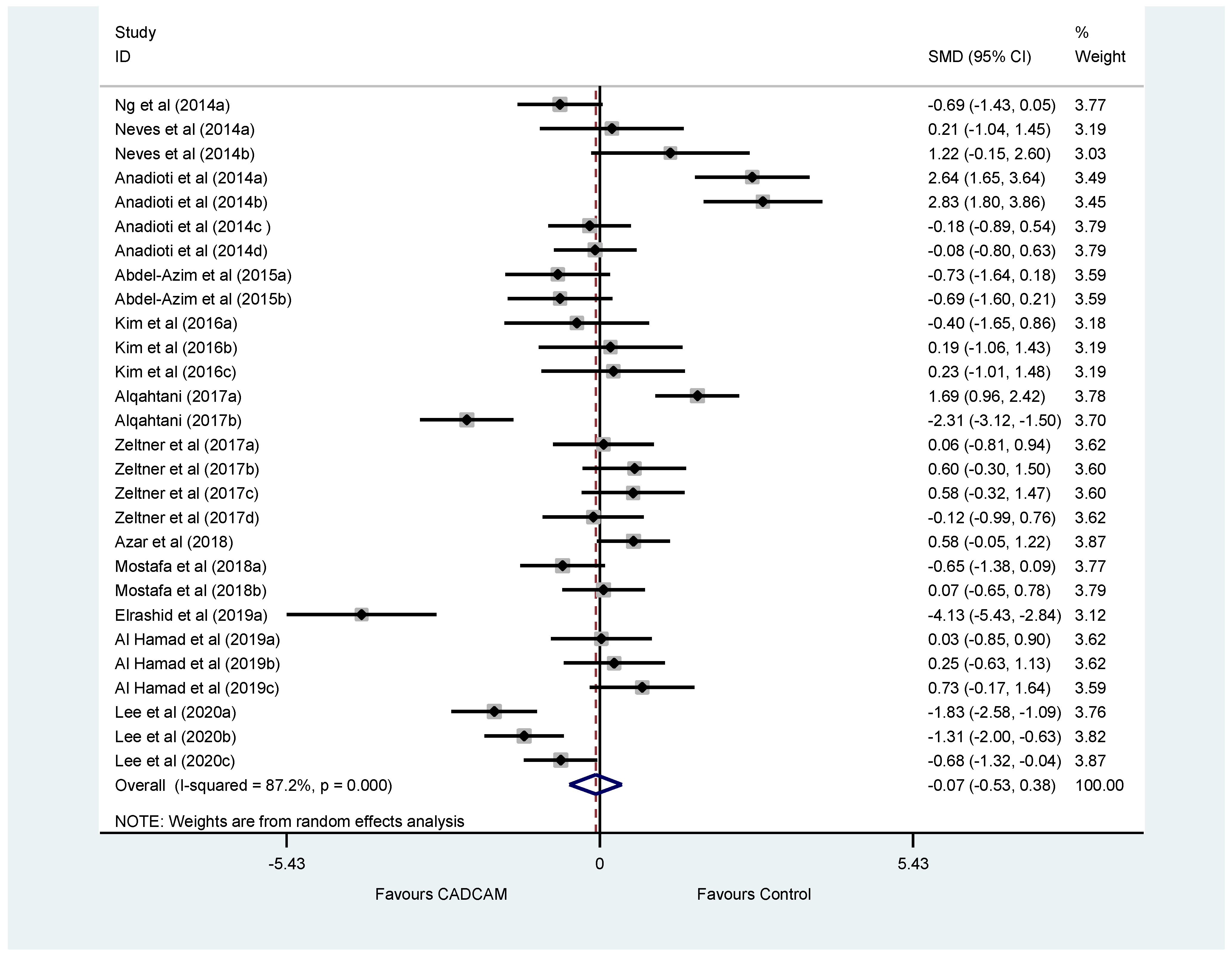
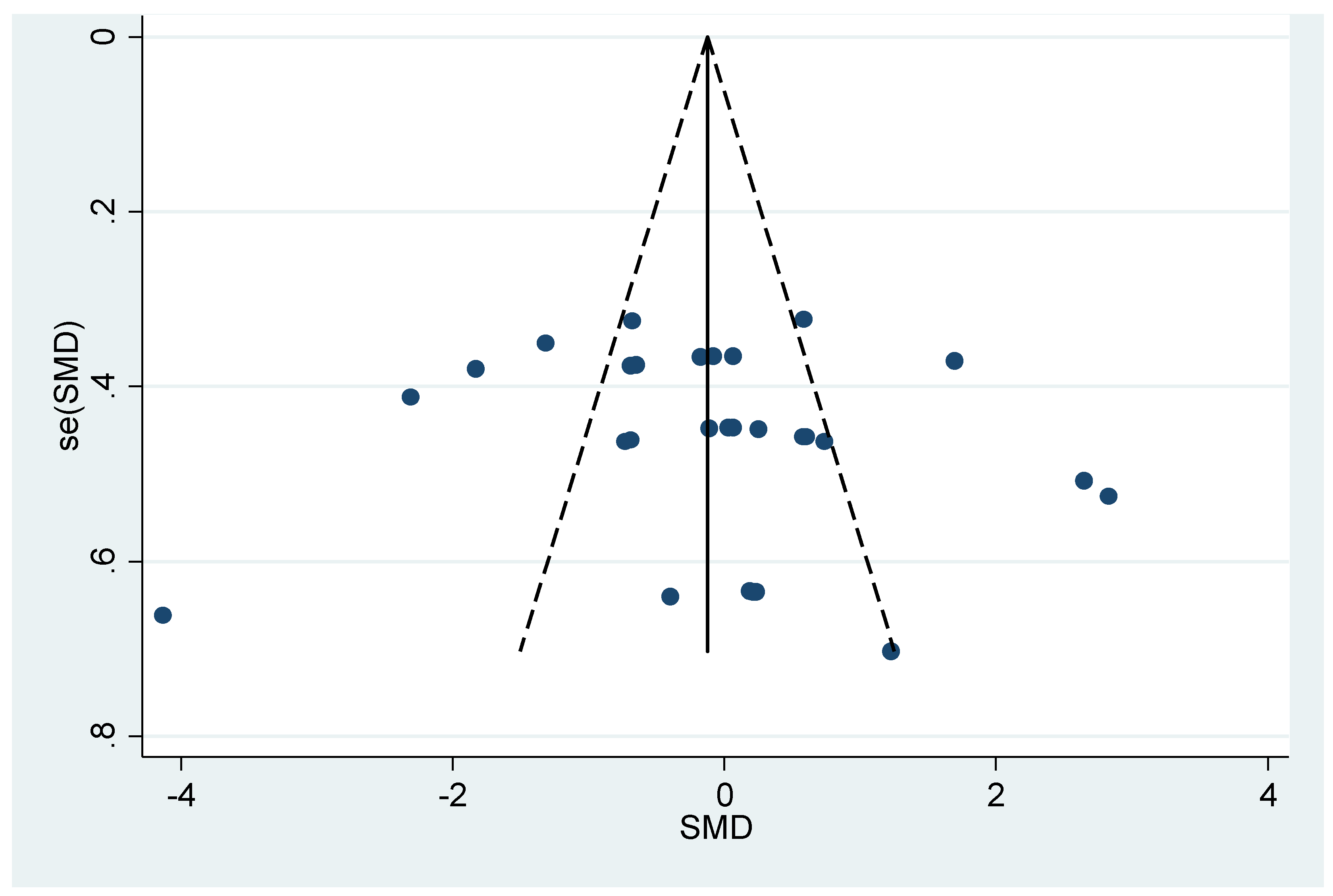
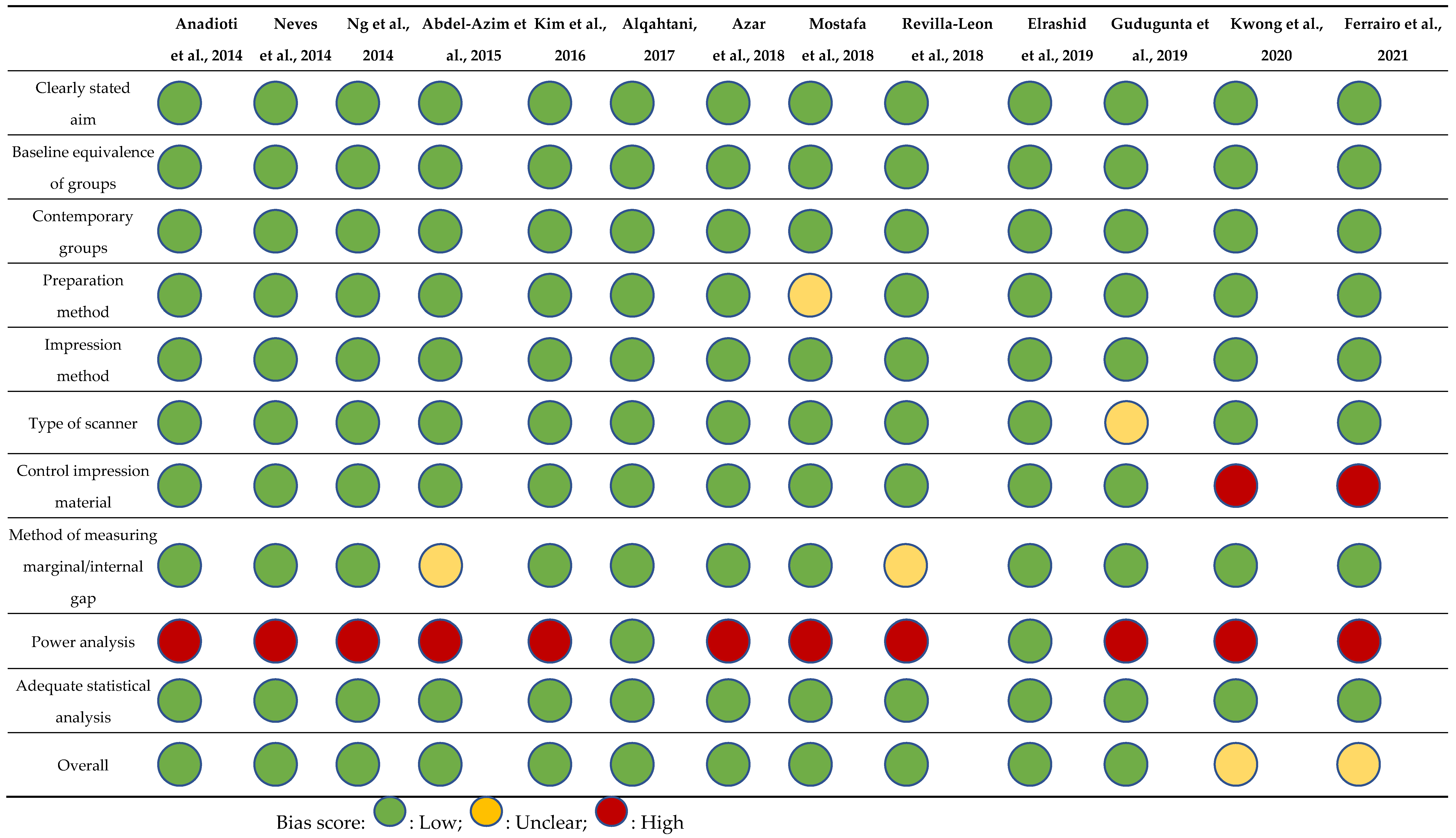

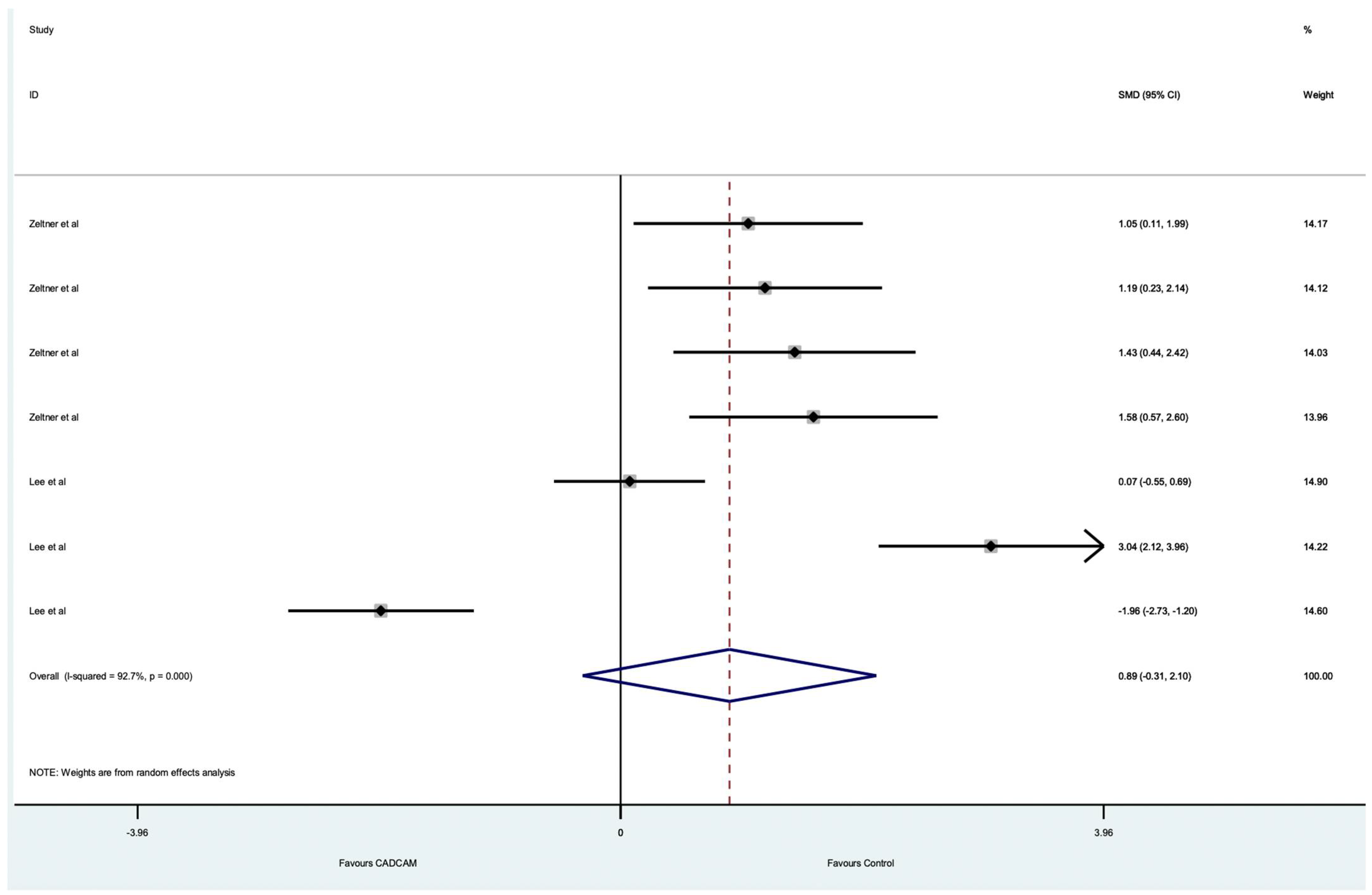
| Inclusion Criteria | Exclusion Criteria |
|---|---|
|
|
| Author | Title |
|---|---|
| Anadioti et al., 2014 [12] | 3D and 2D Marginal Fit of Pressed and CAD/CAM Lithium Disilicate Crowns Made from Digital and Conventional Impressions |
| Neves et al., 2014 [23] | Micro-computed tomography evaluation of marginal fit of lithium disilicate crowns fabricated by using chairside CAD/CAM systems or the heat-pressing technique |
| Ng, Ruse and Wyatt, 2014 [24] | A comparison of the marginal fit of crowns fabricated with digital and conventional methods |
| Abdel-Azim et al., 2015 [25] | Comparison of the marginal fit of lithium disilicate crowns fabricated with CAD/CAM technology by using conventional impressions and two intraoral digital scanners |
| Kim et al., 2016 [26] | Fit of lithium disilicate crowns fabricated from conventional and digital impressions assessed with micro-CT. |
| Alqahtani, 2017 [27] | Marginal fit of all-ceramic crowns fabricated using two extraoral CAD/CAM systems in comparisonwith the conventional technique. |
| Zeltner et al., 2017 [28] | Randomized controlled within-subject evaluation of digital and conventional workflows for the fabrication of lithium disilicate single crowns. Part III: marginal and internal fit |
| Azar et al., 2018 [29] | The marginal fit of lithium disilicate crowns: Press vs. CAD/CAM |
| Mostafa et al., 2018 [30] | Marginal Fit of Lithium Disilicate Crowns Fabricated using Conventional and Digital Methodology: A Three-DimensionalAnalysis. |
| Revilla-Leon et al., 2018 [31] | Marginal and Internal Gap of Handmade, Milled and 3D Printed Additive Manufactured Patterns for Pressed Lithium Disilicate Onlay Restorations. |
| Al Hamad et al., 2019 [32] | Comparison of the Fit of Lithium Disilicate Crowns made from Conventional, Digital, or Conventional/DigitalTechniques |
| Elrashid et al., 2019 [33] | Stereomicroscopic Evaluation of Marginal Fit of E.Max Press and E.Max Computer-Aided Design and Computer-Assisted Manufacturing Lithium Disilicate Ceramic Crowns: An In vitro Study |
| Gudugunta et al., 2019 [34] | The marginal discrepancy of lithium disilicate Onlays: Computer-aided design versus press |
| Ahn et al., 2020 [35] | Clinical evaluation of the fit of lithium disilicate crowns fabricated with three different CAD-CAM systems. |
| Kwong and Dudley, 2020 [36] | A comparison of the marginal gaps of lithium disilicate crowns fabricated by two different intraoral scanners |
| Lee, Son and Lee, 2020 [37] | Marginal and Internal Fit of Ceramic Restorations Fabricated Using Digital Scanning and Conventional Impressions: A Clinical Study |
| Ferrairo et al., 2021 [38] | Comparison of marginal adaptation and internal fit of monolithic lithium disilicate crowns produced by 4 different CAD/CAM systems |
| In vitro studies | 13 [12,23,24,25,26,27,29,30,31,33,34,36,38] |
| In vivo studies | 4 [28,32,35,37] |
| Onlays | 2 [31,34] |
| Crowns | 15 [12,23,24,25,26,27,28,29,30,32,33,35,36,37,38] |
| PVS control used | 14 [12,23,24,25,26,27,28,29,30,31,32,33,34,37] |
| Digital only | 3 [35,36,38] |
| Digital techniques resulted in a more accurate marginal fit of crowns | 5 [24,27,30,33,37] |
| Conventional techniques resulted in a more accurate internal fit of crowns | 1 [28] |
| No clear difference in accuracy of internal fit in either method | 2 [26,37] |
| Unable to compare internal fit of onlay to any other study | 1 [31] |
| No difference in marginal fit with either method | 5 [23,25,26,28,32] |
| Conventional techniques resulted in a more accurate marginal fit of crowns | 2 [12,29] |
| Digital only methods- no difference between digital methods | 2 [35,36] |
| Digital only methods- significant difference between digital methods | 1 [38] |
| Conventional techniques resulted in a more accurate marginal fit of onlays | 1 [31] |
| Digital techniques resulted in a more accurate marginal fit of onlays | 1 [34] |
| Largest marginal gap for crowns | 207.8 μm [26] |
| Smallest marginal gap for crowns | 26.8 μm [33] |
| Largest internal gap for crowns | 285.2 μm [28] |
| Smallest internal gap for crowns | 80 μm [37] |
| Smallest marginal gap for onlays | 41.5 μm [34] |
| Largest marginal gap for onlays | 86.5 μm [31] |
| Smallest internal gap for onlays | 92 μm [31] |
| Largest internal gap for onlays | 96 μm. [31] |
| Author | Type of Study | Type of Scanner | Comparison | Measurement Technique | Outcome of Study | Outcomes |
|---|---|---|---|---|---|---|
| Anadioti et al., 2014 [12] | In vitro study | E4D scanner | PVS impressions | Triple scan protocol and 2D measurements measured at 4 points | Marginal fit | PVS impression and press fabrication technique the most accurate for 3D and 2D marginal fits. |
| Neves et al., 2014 [23] | In vitro study | CEREC 3D Bluecam and E4D scanner | PVS impressions | Scanned with μ-CT. For every image 2 measurements were taken for horizontal and vertical fit at 400× magnification. The crowns were fixed to the die with silicone material. | Marginal fit | Lithium disilicate crowns fabricated using CEREC 3D Bluecam scanner CAD/CAM system or the heat press technique more accurate than crowns fabricated using an E4D Laser scanner system. |
| Ng, Ruse and Wyatt, 2014 [24] | In vitro study | Lava COS scanning unit | PVS impressions | Circumferential marginal gap measurements takenat 8 measurement locations. photographs at 40× with a Die was held in place with a measurement alignment chuck | Marginal fit | The fully digital fabrication method provided better margin fit than the conventional method |
| Abdel-Azim et al., 2015 [25] | In vitro study | Lava COS scanning unit and iTero | PVS impressions | Stereomicroscope with a microscope camera used at 45× magnification and measured at 4 points. A computer software used. | Marginal fit | Digital and conventional impressions were found to produce crowns with similar marginal accuracy |
| Kim et al., 2016 [26] | In vitro study | CS3500/ TRIOS/ Ceramill Map400 | PVS impressions | Crowns were cemented to replica die with zinc phosphate cement and finger pressure. 2D and 3D measurements were used to measure the marginal gap. Internal volume measured using volume of zinc phosphate cement between lithium disilicate crown and replica die. | Marginal fit and internal volume | Significant differences were found between e.max CAD crowns produced using 2 intra-oral digital impressions. |
| Alqahtani, 2017 [27] | In vitro study | CEREC omnicam and TRIOS | PVS impressions | A loading device was used to apply an occlusal load of 3 lbs during the measurement. Scanning electron microscope at a magnification of 50× used to measure. Three measurements were taken for each point, and average was recorded. | Marginal fit | All-ceramic crowns, fabricated using the CAD/CAM system, show a marginal accuracy that is acceptable in clinical environ- ments. The TRIOS CAD group displayed the smallest marginal gap. |
| Zeltner et al., 2017 [28] | Randomised controlled trial | Lava, iTero, CEREC inLab, and CEREC infinident systems | PVS impressions | Replica technique used applying finger pressure. Replica sectioned and measurements taken with light microscopy at 200× magnification using a blinded investigator. | Marginal and internal fit | No significant differences were found between the conventional and digital workflows for the fabrication of monolithic lithium disilicate crowns. |
| Azar et al., 2018 [29] | In vitro study | CEREC Omnicam | PVS impressions | Measurements taken using an optical microscope at 200× magnification. The measurements were performed on 25 points on the finishing line of each tooth | Marginal fit | Lithium disilicate crowns fabricated with the press technique have measurably smaller marginal gaps compared with those fabricated with CAD/CAM technique. |
| Mostafa et al., 2018 [30] | In vitro study | Lava C.O.S. scanning unit | PVS impressions | Crowns were seated using finger pressure and wax. 3D volume was measured circumferentially based on a standardized number of slices for the selected region of interest. Vertical marginal gaps were also measured. | Marginal fit | The results suggested that digital impression and CAD/CAM technology is a suitable, better alternative to traditional impression and manufacturing. |
| Revilla-Leon et al., 2018 [31] | In vitro study | Laboratory based scanner Renishaw DS20. | PVS impressions | Computed tomography (μ-CT) for measurement of marginal and internal gaps. | Marginal and internal fit | All the groups presented less than 100 μm marginal and internal gap. The best marginal and internal fit was still obtained by the conventional handmade procedures. |
| Al Hamad et al., 2019 [32] | Prospective controlled clinical trial | CEREC Omnicam | PVS impressions | Crowns seated using silicone and finger pressure. Replica technique used and gaps analysed using a stereomicroscope at 30× magnification. | Marginal fit | Ceramic crowns, which were made using all-digital approach or cast digitization by a laboratory or intra-oral scanner had comparable fit to those produced by conventional approach. |
| Elrashid et al., 2019 [33] | In vitro. study | Laboratory scanner Exocad smart optical 3D-scanner | PVS impressions | Crowns held on to the die using a custom made holder with a pin. Marginal gap measured using a digital microscope at 50× magnification. | Marginal fit | Lithium disilicate all ceramic crowns fabricated by using CAD-CAM techniques showed lesser marginal gap and better marginal fit compared to the conventional technique. |
| Gudugunta et al., 2019 [34] | In vitro study | CEREC scanner | PVS impressions | The crowns were held on to the dies using try in paste. The marginal gap was measured using a microscope camera at 200× magnification. | Marginal fit | Although there was a statistically significant difference between the two groups, marginal gap of both the groups were in clinically acceptable levels. |
| Ahn et al., 2020 [35] | Prospective controlled clinical trial | CEREC Bluecam, EZIS PO and TRIOS 3 scanners | Comparison with other intra-oral scanners | Crowns seated using silicone and finger pressure. Silicone replica technique used measured using a microscope at 100× magnification. | Marginal fit | The lithium disilicate crowns of all groups showed clinically acceptable fit. |
| Kwong and Dudley, 2020 [36] | In vitro study | TRIOS 3 and E4D scanner | Comparison with other intra-oral scanners | Crowns seated using silicone and finger pressure. Digital stereomicroscopy with a camera at a magnification range of 2–18×. Three measurements were taken at each of the 4 locations | Marginal fit | There was no difference in the marginal gaps of CAD/CAM lithium disilicate crowns constructed using two different intra-oral scanners of different generations. |
| Lee, Son and Lee, 2020 [37] | Prospective controlled clinical trial | EZIS PO, i500, and CS3600 scanners | PVS impressions | Silicone replica technique measured at 60× magnification | Marginal and internal fit | There was a significant difference in the marginal and internal fit of the ceramic crowns fabricated using three intra-oral scanner types and one desktop scanner type |
| Ferrairo et al., 2021 [38] | In vitro study | CERAMILL, CEREC, EDG and Zirkonzahn scanners | Comparison with other intra-oral scanners | Crowns seated on to dies using silicone. Silicone replica technique used. internal space measured using μ-CT and replica technique images by a film thickness images were captured by means of a stereomicroscope at 50× magnification. | Marginal and internal fit | The 4 systems are capable to produce restorations adapted within clinically appropriate levels. |
| Anadioti et al., 2014 [12] | Neves et al., 2014 [23] | Ng et al., 2014 [24] | Abdel-Azim et al., 2015 [25] | Kim et al., 2016 [26] | Alqahtani, 2017 [27] | Azar et al., 2018 [29] | Mostafa et al., 2018 [30] | Revilla-Leon et al., 2018 [31] | Elrashid et al., 2019 [33] | Gudugunta et al., 2019 [34] | Kwong et al., 2020 [36] | Ferrairo et al., 2021 [37] | |
|---|---|---|---|---|---|---|---|---|---|---|---|---|---|
| Clearly stated aim | 2 | 2 | 2 | 2 | 2 | 2 | 2 | 2 | 2 | 2 | 2 | 2 | 2 |
| Baseline equivalence of groups | 2 | 2 | 2 | 2 | 2 | 2 | 2 | 2 | 2 | 2 | 2 | 2 | 2 |
| Contemporary groups | 2 | 2 | 2 | 2 | 2 | 2 | 2 | 2 | 2 | 2 | 2 | 2 | 2 |
| Preparation method | 2 | 2 | 2 | 2 | 2 | 2 | 2 | 2 | 2 | 2 | 2 | 2 | 2 |
| Impression method | 2 | 2 | 2 | 2 | 2 | 2 | 2 | 2 | 2 | 2 | 2 | 2 | 2 |
| Type of scanner | 2 | 2 | 2 | 2 | 2 | 2 | 2 | 2 | 2 | 2 | 1 | 2 | 2 |
| Control impression material | 1 | 1 | 1 | 1 | 1 | 1 | 2 | 1 | 1 | 1 | 1 | 0 | 1 |
| Method of measuring marginal/internal gap | 2 | 2 | 2 | 2 | 2 | 2 | 2 | 2 | 1 | 2 | 2 | 1 | 2 |
| Power analysis | 0 | 0 | 0 | 0 | 0 | 2 | 0 | 0 | 0 | 2 | 0 | 0 | 0 |
| Adequate statistical analysis | 2 | 2 | 1 | 1 | 2 | 1 | 2 | 1 | 1 | 1 | 1 | 1 | 1 |
| Overall | 17 | 17 | 16 | 16 | 16 | 18 | 18 | 16 | 15 | 18 | 15 | 14 | 16 |
| Zeltner et al., 2017 [28] | Al Hamad et al., 2019 [32] | Ahn et al., 2020 [35] | Lee, Son and Lee, 2020 [37] | |
|---|---|---|---|---|
| Type of study | Randomised controlled trial | Prospective controlled clinical trial | Prospective controlled clinical trial | Prospective controlled clinical trial |
| Adequate sequence generation | Yes—low risk | Unclear | Unclear | Unclear |
| Remarks | If 2 or more teeth were available on one patient then just 1 tooth was selected by throwing a die. | One patient with a peg-shaped maxillary left lateral incisor was selected for the study. | 40 participants were used (10 men/ 30 women). No mention of any sequence generation. | 20 participants were used who required a ceramic crown. A power analysis was used. |
| Allocation concealment | Yes- low risk | Unclear | Unclear | Unclear |
| Remarks | The sequence of the crown assessment was randomly allocated to a computer generated list. | No mention of how the different methods were allocated. | Each preparation was scanned using 3 different scanners. No mention of any concealment. | No mention of how the different methods were allocated. |
| Blinding of outcome assessment | Yes- low risk | Unclear | Unclear | Yes—low risk |
| Remarks | One blinded investigator measured all specimens. 3 calibrated clinicians carried out the procedures | Tooth preparations were carried out by a prosthodontist (KQ) and a different prosthodontist (BR) was in charge of the design and milling. | Tooth preparations were carried by an experienced prosthodontist (JBH). The internal fit was evaluated by an examiner (JJA) | The dentist was blinded to the information about the crown. All intraoral processes were prepared by one skilled dentist. A prosthodontist evaluated the quality of the crowns based on the clinician satisfaction score. |
| Incomplete outcome data addressed | Yes | Yes | Yes | Yes |
| Remarks | No incomplete data | No incomplete data | Seven drop-outs | No incomplete data |
| Free of selective reporting | Yes | Yes | Yes | Yes |
| Remarks | The study protocol is available and the primary/secondary outcomes have been reported on. | The study protocol is available and the primary/secondary outcomes have been reported on. | The study protocol is available and the primary/secondary outcomes have been reported on. | The study protocol is available and the primary/secondary outcomes have been reported on. |
| Free of other sources of bias | No- declaration made about support and funding. | Yes | No- declaration made about support and funding. | No- declaration made about support and funding.. |
| Remarks | The study was supported by the Clinic of Fixed and Removable Prosthodontics and Dental Material Science, Center of Dental Medicine, University of Zurich, Switzerland, and by a research grant from Institut Straumann AG, Basel, Switzerland. | None declared | Supported by Industrial Strategic Technology Development Program. Funded By the Ministry of Trade, Industry & Energy (MOTIE, Korea). | Supported by the Ministry of Trade, Industry & Energy (MOTIE, Korea) under the Industrial Technology Innovation Program |
| Overall risk of bias | Low | Medium | Medium | Medium |
Publisher’s Note: MDPI stays neutral with regard to jurisdictional claims in published maps and institutional affiliations. |
© 2022 by the authors. Licensee MDPI, Basel, Switzerland. This article is an open access article distributed under the terms and conditions of the Creative Commons Attribution (CC BY) license (https://creativecommons.org/licenses/by/4.0/).
Share and Cite
Patel, T.; Nathwani, N.; Fine, P.; Leung, A. A Scoping Review of Marginal and Internal Fit Accuracy of Lithium Disilicate Restorations. Dent. J. 2022, 10, 236. https://doi.org/10.3390/dj10120236
Patel T, Nathwani N, Fine P, Leung A. A Scoping Review of Marginal and Internal Fit Accuracy of Lithium Disilicate Restorations. Dentistry Journal. 2022; 10(12):236. https://doi.org/10.3390/dj10120236
Chicago/Turabian StylePatel, Tanya, Neil Nathwani, Peter Fine, and Albert Leung. 2022. "A Scoping Review of Marginal and Internal Fit Accuracy of Lithium Disilicate Restorations" Dentistry Journal 10, no. 12: 236. https://doi.org/10.3390/dj10120236
APA StylePatel, T., Nathwani, N., Fine, P., & Leung, A. (2022). A Scoping Review of Marginal and Internal Fit Accuracy of Lithium Disilicate Restorations. Dentistry Journal, 10(12), 236. https://doi.org/10.3390/dj10120236






